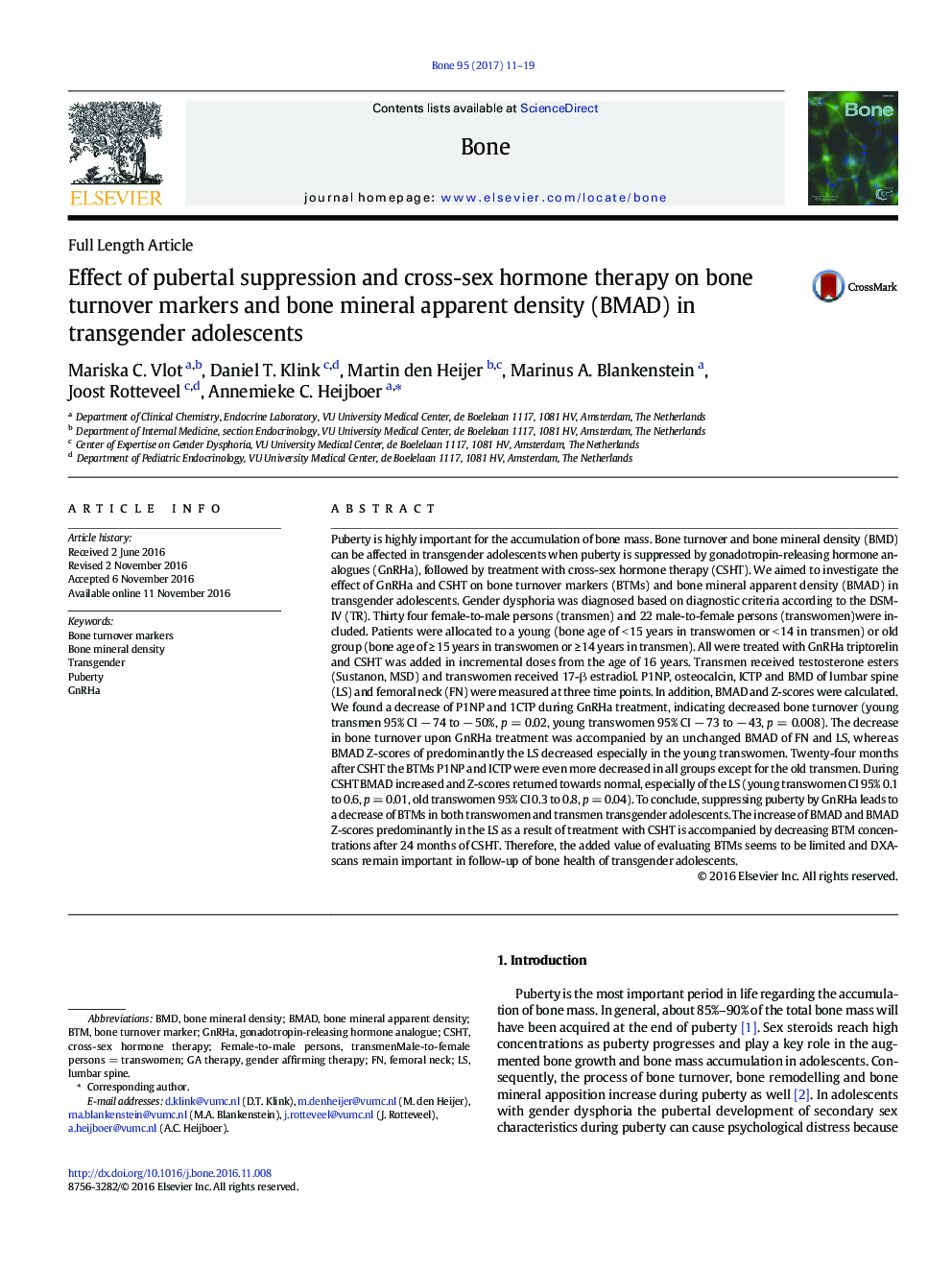| کد مقاله | کد نشریه | سال انتشار | مقاله انگلیسی | نسخه تمام متن |
|---|---|---|---|---|
| 5585338 | 1568124 | 2017 | 9 صفحه PDF | دانلود رایگان |

- The effect of puberty suppression and cross-sex hormone therapy on bone health in transgender adolescents is unknown.
- P1NP and 1CTP decreased during therapy with GnRHa and were even lower after 24Â months of cross-sex hormone therapy.
- The lumbar spine BMAD and Z-scores increased after 24Â months of cross-sex hormone therapy in transgender adolescents.
- Added value of BTM measurements seem to be limited, but DXA-scans remain important in follow-up of transgender adolescents.
Puberty is highly important for the accumulation of bone mass. Bone turnover and bone mineral density (BMD) can be affected in transgender adolescents when puberty is suppressed by gonadotropin-releasing hormone analogues (GnRHa), followed by treatment with cross-sex hormone therapy (CSHT). We aimed to investigate the effect of GnRHa and CSHT on bone turnover markers (BTMs) and bone mineral apparent density (BMAD) in transgender adolescents. Gender dysphoria was diagnosed based on diagnostic criteria according to the DSM-IV (TR). Thirty four female-to-male persons (transmen) and 22 male-to-female persons (transwomen)were included. Patients were allocated to a young (bone age of < 15 years in transwomen or < 14 in transmen) or old group (bone age of â¥Â 15 years in transwomen or â¥Â 14 years in transmen). All were treated with GnRHa triptorelin and CSHT was added in incremental doses from the age of 16 years. Transmen received testosterone esters (Sustanon, MSD) and transwomen received 17-β estradiol. P1NP, osteocalcin, ICTP and BMD of lumbar spine (LS) and femoral neck (FN) were measured at three time points. In addition, BMAD and Z-scores were calculated. We found a decrease of P1NP and 1CTP during GnRHa treatment, indicating decreased bone turnover (young transmen 95% CI â 74 to â 50%, p = 0.02, young transwomen 95% CI â 73 to â 43, p = 0.008). The decrease in bone turnover upon GnRHa treatment was accompanied by an unchanged BMAD of FN and LS, whereas BMAD Z-scores of predominantly the LS decreased especially in the young transwomen. Twenty-four months after CSHT the BTMs P1NP and ICTP were even more decreased in all groups except for the old transmen. During CSHT BMAD increased and Z-scores returned towards normal, especially of the LS (young transwomen CI 95% 0.1 to 0.6, p = 0.01, old transwomen 95% CI 0.3 to 0.8, p = 0.04). To conclude, suppressing puberty by GnRHa leads to a decrease of BTMs in both transwomen and transmen transgender adolescents. The increase of BMAD and BMAD Z-scores predominantly in the LS as a result of treatment with CSHT is accompanied by decreasing BTM concentrations after 24 months of CSHT. Therefore, the added value of evaluating BTMs seems to be limited and DXA-scans remain important in follow-up of bone health of transgender adolescents.
Journal: Bone - Volume 95, February 2017, Pages 11-19